

Planet's impact forms dust disk BBC - July 20, 2005

The Biggest Starquake Ever Space.com - July 18, 2005
Astronomers hope these oscillations will crack the
mystery of what neutron stars are made of.
Hubble spies lord of the stellar rings New Scientist - June 22, 2005

Exploding Star Left No Visible Core PhysOrg - June 6, 2005
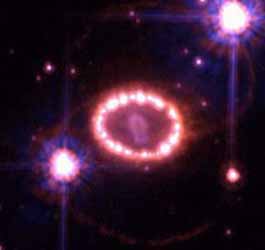
Two burned-out stars are spiralling towards each other New Scientist - June 1, 2005
so quickly they may ripple the fabric of space-time.
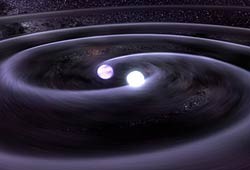
Bizarre Star Brightens Like Clockwork Scientific American - May 17, 2005
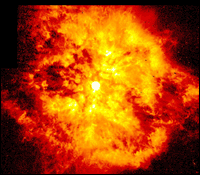
Stars can only grow so big Space.com - March 2005

Light Continues To Echo Three Years After Stellar Outburst Science Daily - February 2005
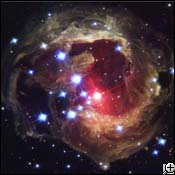
'Bullet Star' Shines 350 Times Brighter Than The Sun Science Daily - January 2005

-
Long Lost Star Catalog Found in Plain Sight - Space.com - January 2005
The long lost star catalog of Hipparchus has been under our noses or,
more accurately, slightly above them for more than 1,800 years.
Ancient Astronomer's Work Found on Roman Statue
Lost Ancient Star Catalogue Found - Discovery - January 2005


-
Stunning New Inside Look at Star Birth Space.com - January 2005

Astronomers have identified the three biggest stars known to science BBC - January 2005

Mystery of Magnetic Stars Solved Space.com - November 2004
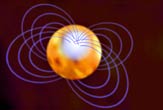
The similarity between a common bar magnet and a star
Deepest Image Of Exploded Star Uncovers Bipolar Jets Science Daily - August 2004

Glowing Results: Rampant Star Birth Left Universal Imprint Space.com - August 2004

There's an intriguing glow across the universe that astronomers
have been trying to pin down for years. Recent observations
appear to have found the source: compact galaxies in the
early universe that were generating stars at a furious pace.
Dying Star Goes Out With A Ring Science Daily - August 2004
Comets, Asteroids and Planets around a Nearby Star Space.com - August 2004

Tiny Hot Spot Found on City-Sized Star Space.com - July 2004

Astronomers have detected a hot spot about the size of a
football field on a city-sized star that is 500 light-years away.
Unique Observations Of Newborn Star Provide Information On Solar System's Origin Science Daily - July 2004
Rare Glimpse of Sun-like Star at Birth Space.com - July 2004
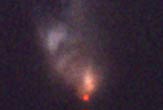
Astronomers Measure Mass Of A Single Star - First Since The Sun Science Daily - July 2004
The Heartbeat of a Dying Star Space.com - May 2004
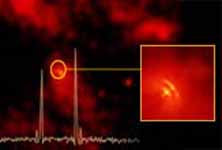
Image of dying star caught by telescope Ananova - April 2004
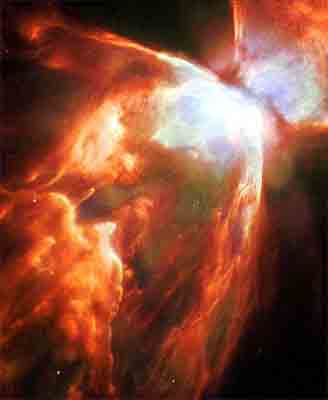
Hubble telescope snares space bug BBC - April 2004
Bug Nebula, a huge mass of gas and dust which hides a hot, dying star.
The Bug Nebula, or NGC 6302, is about 4,000 light-years from Earth in
the southern constellation of Scorpius.
When did stars first form? Physics Web - April 2004
Hubble Sees Stars as Numerous as Grains of Sand in Nearby Galaxy Hubble - April 2004

The Crazy Cosmos: Stars Near Sun are Wild and Wayward Space.com - April 2004

Chandra X-ray Observatory Images Of N49B, The Remains Of An Exploded Star Science Daily - April 2004

The Chandra image of N49B, the remains of an exploded star, shows a cloud
of multimillion-degree gas that has been expanding for about 10,000 years.
Hubble sends dramatic image of distant star not unlike Van Gogh's "Starry Night" - Reuters - March 2004
 -
- 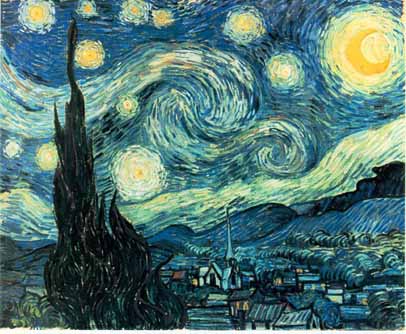
The Hubble space telescope captured an image of a distant star that bears resemblance to the famous Vincent van Gogh painting "Starry Night", NASA and the European Space Agency announced.
The spectacular image taken February 8 showed the star, V838 Monocerotis (V838 Mon), surrounded by an expanding halo of light "complete with never-before-seen spirals of dust swirling across trillions of kilometers of interstellar space", a statement from the agencies said.
"The illumination of interstellar dust comes from the red supergiant star at the middle of the image, which gave off a flashbulb-like pulse of light two years ago," the statement added, describing the image as "nature's own piece of performance art".
The outburst event from V838 Mon, located 20,000 light years away from Earth, is probably the source of the dust haze which it illuminates.
Van Gogh painted "Starry Night" while at the Saint-Remy-de-Provence asylum in southern France, some 13 months before he committed suicide at the age of 37 at Auvers-sur-Oise, near Paris, in 1890.
Diamond star thrills astronomers BBC - February 2004
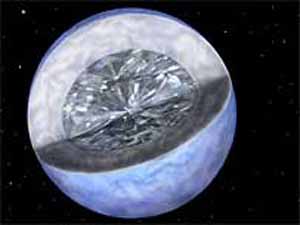
Twinkling in the sky is a diamond star of 10 billion trillion trillion carats.
New star emerges from dust cocoon of gas after it was born BBC
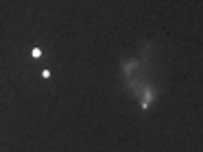
Star Twins Nature - January 2004
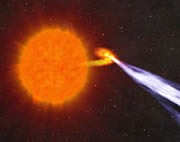 The first double-team of pulsars may reveal secrets of gravity.
Astronomers have realized that a rare set of double stars is made up of two pulsars.
This unique discovery will allow them to test Einstein's theory of relativity in
novel ways, and to better understand the energy beams that pulsars generate.
The first double-team of pulsars may reveal secrets of gravity.
Astronomers have realized that a rare set of double stars is made up of two pulsars.
This unique discovery will allow them to test Einstein's theory of relativity in
novel ways, and to better understand the energy beams that pulsars generate.
Mystery of bizarre double star unraveled MSNBC - January 2004
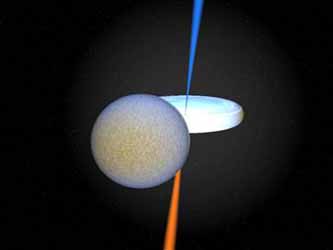
Black hole consumes star but can't digest it all -
This artist's conception shows a super-giant star in front of a black hole in the SS 433 double-star system.
The black hole pulls material from the star, and that material whirls into a disk (shown in white) surrounding
the black hole. All that activity causes the disk to throw off high-speed jets, shown in blue and red.
Biggest Brightest Stars Puzzle Astronomers Space.com - January 2004
A team of researchers has found what appears to be the most luminous known
star around, one so massive that it shouldnąt have formed in the first place.
The star, known as LBV 1806-20, tips the scales of stellar masses at about 150
times the heft of the Sun. It shines up to 40 million times brighter than the Sun.
Scientists find mystery 'orphan planets' Ananova - November 2003
Astronomers have discovered planets that appear
to have been formed without a parent star.
Found: The best place for alien life BBC - October 2003
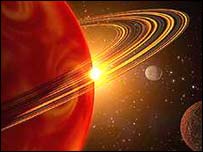
It is the 37th brightest star in the constellation of Gemini to be precise,
42 light years away from Earth and rather like our own Sun.
The star, 37 Gem, is top of a shortlist of the 30 most promising places to
look for life drawn up by Maggie Turnbull of the University of Arizona in Tucson.
Trace gas dates Universe's first stars New Scientist - July 2003
Newfound Stars are Huge, Powerful and Frantic Space.com - July 2003
Astronomers have discovered clusters of stars drifting in what was thought to be the empty space between the galaxies BBC - July 2003
Astronomers count the stars BBC- July 2003
Astronomers in Australia say there are 10 times more stars in the visible
universe than all the grains of sand on the world's beaches and deserts.
Strange star puzzles astronomers June 2003 - BBC
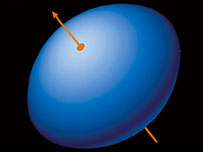
Achernar is one of the most distorted stars ever observed by astronomers.
It is shaped like a child's spinning top.
Star Search Finds Neighborly Red Dwarf Space.com - May 2003
Astronomers have stumbled onto a previously unknown star in Earth's stellar
neighborhood, a red dwarf that appears to be the third-closest star system
to our own - appears to be the third closest star to our solar system.
Hubble glimpses earliest stars May 2003 - BBC

200 million years after the Big Bang
Fifth closest star discovered BBC - February 2003
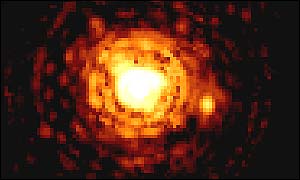
'Oldest star chart' found January 2003 - BBC

The oldest image of a star pattern, that of the famous constellation of Orion,
has been recognised on an ivory tablet some 32,500 years old.
Discovery Of Nearest Known Brown Dwarf January 2003 - Science Daily
A brown dwarf is a 'failed star'
Bright Southern Star Epsilon Indi Has Cool, Substellar Companion
Wandering star destined for dwarfdom? January 2003 - Nature

Young star firing from cosmic slingshot
'Oldest' star found in galaxy November 2002 - BBC

Star Nurseries September 2002 - Discovery
A new star is born every year in our galaxy.
Young Stellar Clusters Found In Old Galaxy June 2002 - UniSci
February 24, 2001 - Space.com
Complex carbon molecules and water, which are key ingredients for life, have been found in the dust and gas around distant stars. The findings boost the theory that the cosmic stew of life is common in the universe.
Astronomers reported that orbiting observatories probing the space around both young and dying stars have found vast waves of water vapor and clear traces of carbon molecules that can play a basic role in organic chemistry.
"This strengthens greatly the possibility of life forming elsewhere," said Martin F. Kessler, a staff scientist for the European Space Agency (ESA). "It shows that complex carbon chemistry is not unique to Earth. We now see similar chemistry elsewhere in the universe."
The findings don't prove that life exists beyond Earth, said Martin Harwit, a Cornell University astronomer. "But it proves that the conditions that led to the formation of life and our solar system are present in lots of places."
ALPHABETICAL INDEX OF ALL FILES